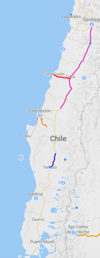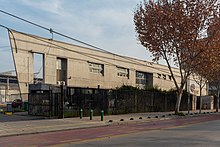|
Empresa de los Ferrocarriles del Estado
Empresa de los Ferrocarriles del Estado (abbreviated EFE, lit. State Railway Company) is the national railway and the oldest state-run enterprise in Chile. It manages the infrastructure and operating rail services in the country. Track gaugeThe track gauge is Indian gauge 1,676 mm (5 ft 6 in) in the south and 1,000 mm (3 ft 3+3⁄8 in) metre gauge in the north. The Santiago Metro uses 1,435 mm (4 ft 8+1⁄2 in) standard gauge. History The company was created on January 4, 1884 by means of the purchase of the companies that exploited the longitudinal routes and the Santiago – Valparaíso route. Since then, the company acquired the railways of the sodium nitrate mining companies in the north of Chile. From 1913 on the network of the EFE extends from Iquique to Puerto Montt. Apart from the company, Chilean Army also built a 60 kilometres (37 mi) small rail line, known to be Puente Alto-El Volcan Railway for Military purpose to safeguard from Argentina attacks, which were opened in 1914 and closed during 1985.[1][2][3][4] (more translation from es:Empresa de los Ferrocarriles del Estado#Historia to come) A stable political and economic climate allowed EFE to start its largest-ever investment programme during the administration of Ricardo Lagos. This involved the spending of US$1 billion between 2003 and 2005, in order to increase capacity on commuter networks and improved long-distance services, as well as reconnecting Santiago with Puerto Montt via Temuco.[5] Unfortunately, the project was involved in a series of corruption scandals and bad administration. The long-distance service trains, bought from the Spanish railway company RENFE, had serious flaws, and the service to Puerto Montt was closed some months later. This situation, triggered investigations from the government, who exposed the crisis of the company due to the administration mistakes. During the last decade, the company has been revitalized, thanks to the state investments during the administrations of Michelle Bachelet and Sebastián Piñera, as well as the reestablishment and renovation of old routes, complemented with the integration of some of this routes with the Santiago, Valparaíso and Concepción public transport systems. SubsidiariesPassenger rail
Freight services
Special tourist servicesFuture expansionProposed future rail infrastructure includes a new, more direct rail line between Santiago and Valparaíso, and expansions of Santiago's commuter rail network to Melipilla and Batuco. Rail links with adjacent countries
See alsoReferences
External linksWikimedia Commons has media related to Empresa de los Ferrocarriles del Estado. |
||||||||||||||||||||||||||

